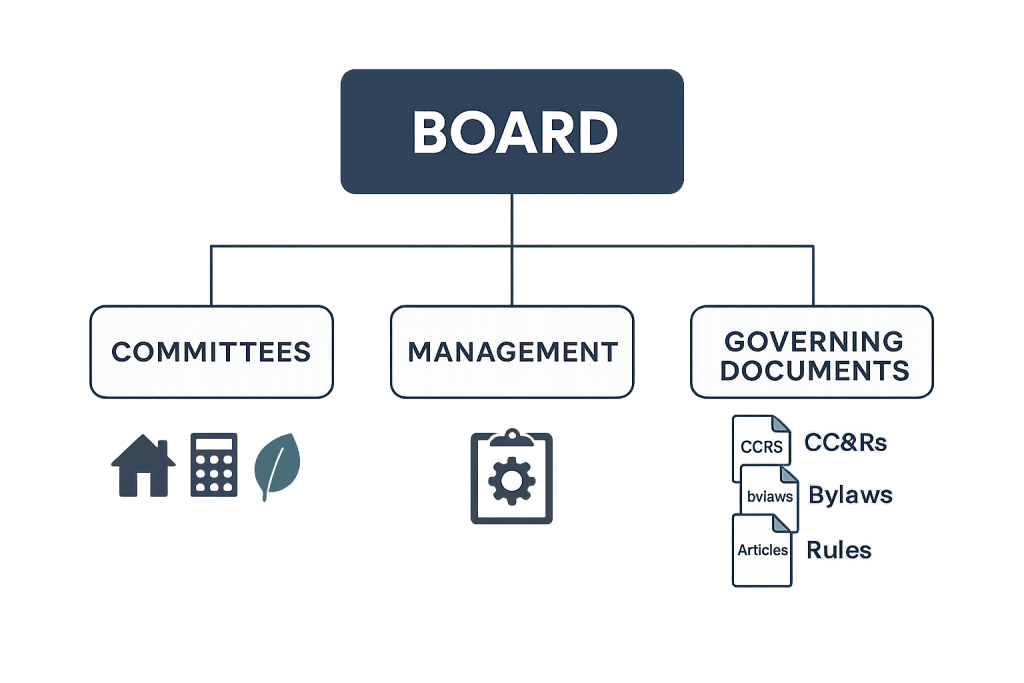
Homeowners’ associations run on people, process, and policy—and understanding the HOA governance structure helps homeowners know who decides what, how rules are enforced, and where to get involved. In short, the HOA governance structure defines who sets policy, who executes it, and how owners can influence outcomes.
- Board = decision-makers; committees and (sometimes) a manager execute.
- Key documents: CC&Rs, bylaws, articles, and rules/regulations.
- Your voice matters: attend meetings, vote, serve, or run for the board.
- Modern HOAs use software for transparency, elections, documents, and dues.
On this page
- How the HOA governance structure works
- Board of Directors in the HOA governance structure
- Common committees
- Professional management companies
- Governing documents that define the hoa governance structure
- How homeowners participate in the hoa governance structure
- How RunHOA supports good governance
- FAQ
How the HOA governance structure works
Most associations use a representative model: members (owners) elect a Board of Directors to set policy and make decisions. Boards may delegate work to committees and, in many communities, hire a professional management company for day-to-day tasks. All of this operates within the framework of your community’s governing documents and state law—and together forms the HOA governance structure.
Board of Directors in the HOA governance structure
The board is the central governing body elected by homeowners. Officers are chosen from among directors after each election.
| Officer | Primary Responsibilities | Helpful RunHOA Features |
|---|---|---|
| President | Chairs meetings, executes board decisions, represents the HOA. | Communications, Calendar |
| Vice President | Acts in president’s absence; leads special initiatives. | Requests/Workflows |
| Secretary | Records minutes, maintains records, sends notices. | Documents, Email Blasts |
| Treasurer | Budgeting, dues/assessments, financial reporting, reserves. | Accounting, Dues & Payments |
Common committees
- Architectural Review Committee (ARC): Reviews exterior changes for CC&R compliance.
- Finance/Budget: Assists with budgeting, forecasts, and reserve planning.
- Landscaping/Maintenance: Oversees common areas and vendor performance.
- Social/Events: Builds community through gatherings and programs.
- Compliance: Supports fair, consistent rule enforcement.
Professional management companies
Boards in larger or complex communities often partner with a management company to handle collections, vendor coordination, compliance notices, owner support, and records. The board retains decision authority; management executes.
Governing documents that define the HOA governance structure
- CC&Rs: The “what you can/can’t do” covenants that protect community standards.
- Bylaws: The HOA’s operating rules (elections, meetings, quorum, officers, voting).
- Articles of Incorporation: Establish the HOA’s legal entity and high-level purpose.
- Rules & Regulations: Day-to-day policies (amenities, hours, trash, parking) that are easier to update than CC&Rs.
Pro tip: Centralize your docs and minutes so owners can self-serve. Try RunHOA Documents and link it from your website and welcome emails.
How homeowners participate in the HOA governance structure
- Attend meetings: Stay informed, ask questions during open forum.
- Vote: Elect directors and weigh in on amendments or special approvals—consider secure online voting to boost turnout.
- Serve: Join a committee that matches your skills.
- Run: Stand for the board to shape budgets, policy, and priorities.
How RunHOA supports good governance
- Transparency & communication: Email blasts & newsletters, announcements, meeting calendar.
- Elections & surveys: Online voting and owner surveys increase participation.
- Financial clarity: HOA accounting and dues & payments streamline collections and reporting.
- Compliance & requests: Violations, ARC/work requests, and vendor management.
- Onboarding & access: Owner/Board directory, role-based access, documentation in Initial Setup.
FAQ
Who has ultimate authority—the board, management, or the membership?
The membership elects the board. The board governs within the limits of the governing documents and state law. A management company is an agent that carries out board policy; it does not outrank the board or the membership.
Can the board change rules without a membership vote?
Boards can usually adopt or amend rules & regulations by board vote after proper notice and an open meeting. Changes to CC&Rs generally require a member vote—often a supermajority—per your documents and statute.
What happens if an owner doesn’t follow the CC&Rs?
Most HOAs use a due-process ladder: written notice, an opportunity to be heard, and if unresolved, fines or other remedies authorized by the documents and law. Serious or ongoing issues may involve legal action.
Are HOA meetings open to owners?
Regular board meetings are typically open to owners except for limited executive-session topics (e.g., legal matters, personnel, certain collections). Look for posted agendas and minutes or check your owner portal.
What documents define how the HOA is governed?
The core set is CC&Rs, bylaws, articles of incorporation, and rules/regulations. Together these establish the HOA governance structure and the procedures for elections, meetings, notices, and enforcement.
How does the HOA governance structure affect homeowners?
It determines who makes decisions, how budgets are set, what standards apply, and how you can participate—by attending meetings, voting, serving on committees, or running for the board.
Related guides: Initial Setup · Create Users · HOA Website · RunHOA Support
Further reading: Community Associations Institute · HUD: Fair Housing Act overview · Consumer Finance: homeowner rights basics
Short answer: An HOA is governed by an owner-elected board that uses committees and (sometimes) a management company to carry out work, all under the authority of the CC&Rs, bylaws, articles, and rules. Owners influence outcomes by attending meetings, voting, serving, and running for the board.